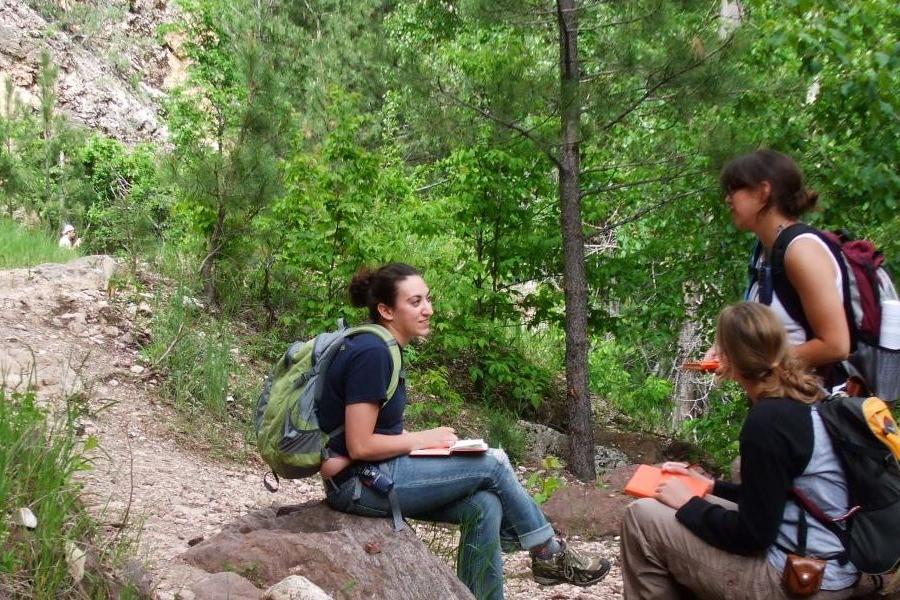The Environmental Science and Design Research Institute fosters innovative, interdisciplinary research at the intersection of natural, human and built systems. Our mission is to generate new knowledge, develop practical solutions and create transformative designs that address pressing environmental challenges—locally, regionally and globally.
We champion research and creative activities grounded in scientific methods and design thinking. ESDRI brings together students, faculty and community partners to explore the complex relationships among biological, social, cultural and economic systems. These dynamics shape the availability of essential resources, support biodiversity and influence human health and well-being.
Students: The institute aims to build research skills in students, in order to cultivate well-rounded, critical thinking professionals. ESDRI recognizes the professional and personal importance of students having foundational research or creative experiences, professional skills, and environmental knowledge, which is facilitated through a variety of workshops, speakers, forums, special events, socials, one-on-one guidance, and more. The institute supports undergraduates through its Fellowship Program, in hopes of mentoring a new generation of scholars. ESDRI supports graduate students through its Graduate Student Research Awards. All students are encouraged to share their work at the ESDRI Research Showcase each Spring.
View Current ESDRI Fellows
Faculty: ESDRI provides many opportunities for faculty to advance their research and facilitates multidisciplinary collaborations, procuring intramural and extramural funding, and working with qualified student researchers. The institute engages a broad range of talented scientists, designers, and practitioners, spanning many academic disciplines, fields, and programs. The institute proudly hosts an annual Sustainability Forum, with an ever-evolving theme, which draws from KSU faculty, students, and many of our community partners.
Academic units represented within ESDRI include:
- Aeronautics and Engineering
- Architecture and Environmental Design
- Art
- Biological Sciences
- Chemistry and Biochemistry
- Communication and Information
- Earth Sciences
- English
- Fashion
- Geography
- Peace and Conflict Studies
- Political Science
- Public Health
- Recreation, Park and Tourism Management
- Teaching, Learning and Curriculum Studies
View ESDRI-affiliated Faculty Members
By empowering environmental research, the institute aims to foster change by drawing from robust, well-informed science and design or extrapolating on the research ourselves. ESDRI encourages students, faculty, and the greater community to understand and leverage the interacting geological, biological, human, economical, cultural, and social systems around us. These overlapping systems impact and regulate the availability of resources (e.g. pure water, clean air, and food), sustain diversity of life on Earth, promote well-being, and affect all of us in our daily life.

Climate change is a complex problem with no easy answers—and everything at stake.

Two significant environmental issues our nation faces today include invasive plant species and a lack of sustainable materials. Invasive plant species are detrimental to host environments for multiple reasons. Kent State students are working to turn invasive plant species into a sustainable material that can help protect the environment through the 2022 Biodesign Challenge, a course and national competition to create sustainable solutions to real world problems.

The central component of the Grind2Energy systems at Kent State University are larger versions of the in-sink garbage disposals found in many homes. The difference is that at Kent State, these units aren’t disposing of food waste, but processing it with a purpose - as the first part of a highly sustainable innovation that creates energy and high-grade fertilizer.

If you see Alicia Costello in your area, give her a wave!

Scott Sheridan, Ph.D., professor and chair of the Department of Geography, in the College of Arts and Sciences at Kent State University, was recently selected to become an inaugural American Geophysical Union (AGU) LANDInG (Leadership Academy and Network for Diversity and Inclusion in the Geosciences) Academy Fellow.

Many wonder if climate change is the reason we’ve had 'weather whiplash' or day-to-day dramatic changes from hot to cold or cold to hot. As a climate scientist, Cameron Lee, assistant professor in the Department of Geography in the College of Arts and Sciences at Kent State, gets asked this question a lot. Looking beyond just the average temperatures and statistical means, he decided to take a more analytical look at weather whiplash and add to a growing body of climate change literature examining temperature variability trends.
Timothy Assal, Ph.D., assistant professor in the Department of Geography, was awarded a grant as a co-principal investigator on a multi-institutional project, “Vulnerability of lower-ecotone aspen forests to altered fire regimes and climate dynamics in the northern Great Basin” (a three-year $299,842 total award with $89,600 going to Kent State), which is funded by the Northwest Climate Adaption Science Center. This collaboration includes the United States Geological Survey in Boise, Idaho, Utah State University, and the United States Bureau of Land Management.

Kent State's Jonathan Maletic, Ph.D., in the Department of Computer Science and Tara Smith, Ph.D., in the College of Public Health are the winners of the 2021 Faculty Outstanding Research and Scholarship Awards (ORSAs). The ORSAs recognize the hard work and dedication of faculty members who have been with Kent State for more than 10 years. Read more about the winners and how they display the highest levels of scholarship.

Researchers from Kent State University and the University of New Mexico determined how nitrogen-fixing plants and soil microbes contribute to the overall nitrogen availability in the Chihuahuan desert in New Mexico.






